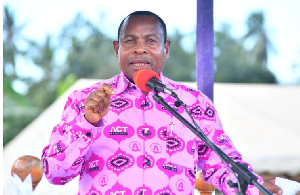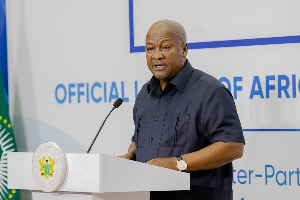Minority members of the opposition New Patriotic Party in Parliament say Ghana’s current economic crisis is the worst in the country's history in the last two decades. Minority Leader Osei Kyei-Mensa-Bonsu made this assertion when he delivered the minority's version of what it calls the "true state of the nation address".
This was to counter President Mahama's constitutionally mandated address delivered on February 26 this year. The Minority had described the President's address as unimpressive because they believe it was a repetition of promises in the past that had no hope for the future.
President Mahama generally addressed every facet of national development with a promise to transform the Ghanaian economy and put it on a sound footing. The critical point in his address was a promise to fix the country's recurring energy crisis, which is currently in its worst state.
Addressing the minority's press conference on Monday March 9, the Minority Leader, Osei Kyei Mensah-Bonsu, noted that although in 2014 the average Gross Domestic Product (GDP) growth in the West Africa monetary zone was provisionally stated at 6.2 percent, Ghana’s GDP growth rate (oil included) was 4.2% and the non-oil sector grew at only 3.5%.
“So Ghana was the country that was pulling the average GDP growth rate in the West African monetary zone growth downwards,” he noted.
“Mr President that is the plain truth, but you did not tell Ghanaians,” he added.
The Minority Leader further stated that at the close of 2013, Ghana was the only country out of the six West African monetary zone countries that had failed to attain even one of the ten convergent criteria for the second year in secession; adding that, “In 2014, Ghana scored zero out of the ten convergence criteria involving the four primary and six secondary criteria.”
“Mr President, this abysmal performance has not been seen in 22 years in Ghana. This is the true state of Ghana’s economy. The state of the economy is in such shambolic state that on Thursday March 12, 2015, the Minister of Finance is presenting to Parliament a reviewed budget for 2015. Note that this is not a supplementary budget… this means that we are throwing aside the 2015 budget approved in December 2014 only two months after the approval.”
Osei Kyei Mensah-Bonsu also indicated that it is possible that Ghana could slip back into the Highly Indebted Poor Country (HIPC) status.
“Ghana is on a super highway of unsustainable debt levels that pushed us to HIPC. At this rate, the international rating agencies may soon classify Ghana as a country with high risk of debt distress and thus compromise our ability to raise further financing from the international capital market and worst still incapacitate the country from servicing and paying our debts,” he added.
The Minority responded to virtually every issue the President raised ranging from health, infrastructure expansion, energy crisis, corruption among others. In all of these, the minority believes the President was not truthful with the bare facts.
The Minority refuted rubbished President Mahama's assertion that his predecessors made only managed the cyclic power crisis without any attempts to find a lasting solution to the problem.
Ghana is currently shedding between 400 and 700 Megawatts of power between off-peak and peak periods due to a shortfall in production.
The Minority Leader Osei Kyei Mensa-Bonsu said former President John Kufuor was able to add about 1,452 Megawatts to the country’s installed capacity during his two terms in Office.
He said the Kufuor administration also saved the country additional 120 Megawatts through policies that ensured that all homes used power-saving bulbs.
In addition to these, Mr Mensah Bonsu said the importation of containerised CAT generating plants in 2007 during a similar energy crisis to add 126 Megawatts to the production capacity meant that the former President bequeathed to the country, a total of 1,698 Megawatts of installed capacity.
General News of Monday, 9 March 2015
Source: tv3network.com













